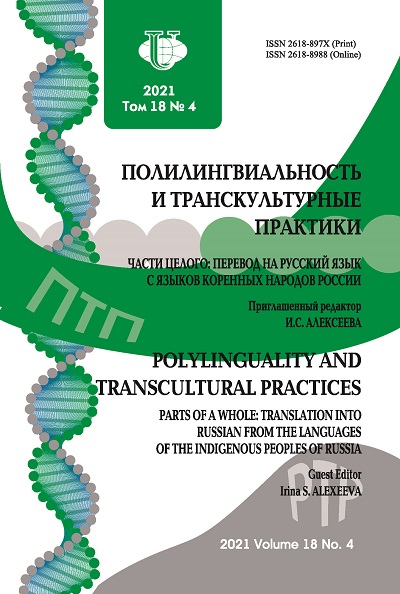Translation in the Context of Preserving Languages and Cultures of the Siberian Indigenous Population
- Authors: Valkova Y.E.1, Razumovskaya V.A.2
-
Affiliations:
- Financial University under the Government of the Russian Federation
- Siberian Federal University
- Issue: Vol 18, No 4 (2021): PARTS OF A WHOLE: TRANSLATION INTO RUSSIAN FROM THE LANGUAGES OF THE INDIGENOUS PEOPLES OF RUSSIA
- Pages: 393-404
- Section: Articles
- URL: https://journals.rudn.ru/polylinguality/article/view/29674
- DOI: https://doi.org/10.22363/2618-897X-2021-18-4-393-404
Cite item
Full Text
Abstract
In this article we’ve focused on the topical problem of preserving the languages and cultures of indigenous peoples of Siberia, which can be solved through the translation of ethnic texts (as an important category of Siberian texts) into Russian and other languages, and translation of texts of great cultural and religious significance from Russian and other languages into languages of Siberian peoples. We aim to study initiatives of individual scholars and enthusiasts who have been translating both “strong” texts from indigenous languages of Siberian peoples and “strong” texts of Russian literature (mostly religious ones) into these languages. The ethnic literature of the peoples of the Krasnoyarsk Krai is considered in historical and comparative perspective, taking into account the national and cultural conditions of these peoples. The conclusion concerns the importance of ethnic translation with the cultural information and memory as the key unit of translation and the saving of the unique languages and cultures of Siberia as its main task.
About the authors
Yulia E. Valkova
Financial University under the Government of the Russian Federation
Author for correspondence.
Email: julyvalkova@gmail.com
ORCID iD: 0000-0001-5231-4720
Candidate in Philology, senior lecturer
49, Leningradsky prospect, Moscow, 125167, Russian FederationVeronica A. Razumovskaya
Siberian Federal University
Email: veronica_raz@hotmail.com
ORCID iD: 0000-0002-0751-7964
Candidate in Philology, professor
79/10, Svobodny prospect, Krasnoyarsk, 660041, Russian FederationReferences
- Trufanov, D.O., Rafikov, R.G. 2017. “Siberia as a multi-ethnic region”. Siberian Socium 1: 96–113. Print. (In Russ.)
- Socio-demographic portrait of Russia: based on the results of the All-Russian the 2010 National Population Census. Federal State Statistics Service. Moscow: SIC publ. Statistics of Russia, 2012, 183 p. Print. (In Russ.)
- Lotman, Yu.M. 1992. “Semiotics of culture and the concept of text”. Selected articles in three volumes. Vol. I. Articles on Semiotics and Typology of Culture. Tallinn: “Aleksandra” publ. Pp. 129–132. Print. (In Russ.)
- Koptseva, N.P. (ed.) 2012. “Indigenous small-numbered peoples of the North and Siberia under conditions of global transformations (on the material of the Krasnoyarsk Krai)”. Part 1. Conceptual and methodological bases of the research. Ethnocultural Dynamics of Indigenous SmallNumbered Peoples of the Krasnoyarsk Krai. Krasnoyarsk: Siberian Federal University publ. Print. (In Russ.)
- Anisimov, K.V. 2010. Editor’s note. Siberian text in the national plot space. Krasnoyarsk: Siberian Federal University publ. Pp. 3–6. Print. (In Russ.)
- Yanushkevich, A.S. 2004. “Siberian text: a view from the outside and inside”. Siberia: a view from the outside and inside. Spiritual Dimension of Space. Irkutsk. Pp. 227–235. Print. (In Russ.)
- Razumovskaya, V. 2014. “Translating Aboriginal Siberian and Circumpolar Cultures in Russia”. In Translators, Interpreters, and Cultural Negotiators Mediating and Communicating Power from the Middle Ages to the Modern Era. Edited by F.M. Federici & D. Tessicini. London: Palgrave Macmillam. Pp. 190–212. Print.
- Razumovskaya, V. 2015. “Siberia in the Mirror of Other Cultures: Literature and Translation”. Journal of Siberian Federal University. Humanities & Social Sciences 12 (8): 2939–2946. Print.
- Languages of the peoples of Russia. Red Book. Encyclopedic Dictionary-Reference Book. 2002. (Ed. by V.P. Neroznak). Moscow: Academia publ. Print. (In Russ.)
- Averin, A.N. 2005. “Ethnosociology. New Data on the Dynamics of Indigenous Minorities of Russia”. Sociological Studies 2: 77–79. Print. (In Russ.)
- Prischepa, V.P. 2012. “Problems and reasons of A.V. Prelovskiy’s turn to translation of texts of Siberian national poets”. The World of Science, Culture, Education 1: 351–353. Print. (In Russ.) 12. Prelovskiy, A.V. 1984. “Autobiographical Notes”. Selected verses and poems. 1955–1981 3–27. Moscow: Khudozhestvennaya literature publ. Print. (In Russ.)
- Rufova, E.S. 2011. The creativity of P.N. Chernykh-Yakutsky in the context of the literary process of Yakutia in the early 20th century. Abstract of Thesis of Candidate of Philological Sciences. Yakutsk, 23 p. Print. (In Russ.)
- Khairullin, V.I. 1999. “Culture in the paradigm of translation studies”. Translator’s Notebooks 24. Moscow: MSLU publ. Pp. 38–44. Print. (In Russ.)
- Kistova, A.V., Pimenova, N.N., Reznikova, K.V., Sitnikova, A.A., Kolesnik, M.A., and Khudonogova, A.E. 2019. “Religion of Dolgans, Nganasans, Nenets and Enets. Journal of Siberian Federal University”. Humanities and Social Sciences, 12(5): 791–811. P. 800. Web. URL: https:// doi.org/10.17516/1997-1370-0424
- Andreeva, T. 2015. “On the main directions of the Evenki language and folklore studies”. Arctic of XXI century. Humanities 3(6): 85–92. Print.
- Bulatova, N.Ya. 2008. “Some Problems of Translating the Bible into the Evenki language”. Translation of the Bible as a Factor in Preservation and Development of Languages of the Peoples of the Russian Federation and the CIS. Conference Proceedings. Мoscow. Pp. 32–36. Print.
- “Nenets people”. Ethnoatlas: peoples and nationalities inhabiting Krasnoyarsk Krai. Web. URL: http://www.krskstate.ru/about/narod/etnoatlas/0/eid/85. (In Russ.)
- “On the first experience of creating the Yakut alphabet”. News of Siberian Science. 14.03.2018. Web. URL: http://www.sib-science.info/ru/institutes/pervyy-opyt-sozdaniyayakutskogo-13032018. (In Russ.)
- Novik, E.S. (Ed.) “Bibliography”. Mythological prose of small peoples of Siberia and the Far
- East. Web. URL: http://www.ruthenia.ru/folklore/novik/04.Lit.(F).htm (In Russ.)
- “Nganasan language”. Endangered languages of the peoples of Siberia. Web. URL: http://lingsib. iea.ras.ru/ru/languages/nganasan.shtml (In Russ.)
- Zhovnitskaya, S.N. 2009. “Nya people — “real people”. Finno-Ugoria. Ethnic comfort 1 (6). (In Russ.)
- “Selkup language”. Endangered languages of the peoples of Siberia. Web. URL: http://lingsib. iea.ras.ru/ru/languages/selkup.shtml. (In Russ.)
- Bykonya, V.V., Kuznetsova, N.G. 2000. “Samoyedic direction of A.P. Dulzon’s linguistic school”. Problems of Linguistics 1: 12–20. (In Russ.)
- “Entsy writing”. Web. URL: https://porarctic.ru/ru/projects/entsy-writing/(In Russ.)
- Koptseva, N.P., Amosov, A.E., Kistova, A.V., Kolesnik, M.A., Libakova, N.M., Luzan, V.S. et al. 2018. Creating works of children’s literature in native languages of the indigenous peoples of the North and Siberia. Krasnoyarsk: SFU publ. Print. (In Russ.)















